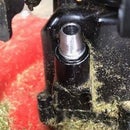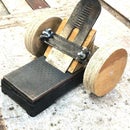Introduction: Bicycle Torque Wrench From a Fisherman's Scale
Occasionally when working on your bicycle it is advisable to use a torque wrench suitable for measuring inch pounds. The infrequent user does not particularly want to pay out twenty to forty dollars for a tool that seldom gets used. You can do your torquing jobs with an investment of only six dollars for a dial indicator fisherman's scale. You probably have the other things you will need.
Step 1: Calibrating the Scale
Torque is force over distance. Pulling the end of a ten inch bar with a force of four and one-half pounds will put a torque of 45 inch pounds on a hex key.
Get a dial indicator fisherman's scale at a sporting goods department. These run about six dollars and read up to 50 pounds in one-half pound increments.
Your scale may be accurate at some weights, but may vary at others. Calibrating the scale is easy. My carbon fiber seat post has a recommended torque of 45 inch pounds. I want to place a weight of 4.5 pounds at the end of a ten inch bar.
Water weighs 8.33 pounds per gallon. There are 8 pints to a gallon and 2 cups to a pint. The weight of a plastic milk jug is negligible. Use a kitchen measuring cup to pour four pints and one cup of water into the milk jug.
Step 2: Weigh the Jug
Hang the jug from the fisherman's scale with a wire tie and take note of the reading. In this case, the scale read 4.5 pounds with four pints and one cup of water in the jug. (In the photo the scale needle cannot be seen, but you can see how to attach the milk just with a wire tie.)
Had the scale given an erroneous weight, compensation would need to be made. Suppose the scale had read 5 pounds instead of 4.5 pounds. 5 divided by 4.5 is 1.11. The scale would have read above the actual reading by 11 percent. This means the distance between the hex key and the point at which the scale attaches would need to be extended by 11 percent to yield the proper torque. Multiply ten inches by 0.11 for the distance to be added, which would be 1.1 inches. A tenth of an inch is just slightly less an eighth of an inch. If the scale reads light rather than heavy, shorten the bar length.
Step 3: Attaching the Hex Key
A 12 inch adjustable wrench holds the hex key tool in its jaws and provides almost exactly the correct length of a bar for your home brew torque wrench. The sides of the hex key tool should be smooth. Grind the ends of the bolts holding the handles together to make the side surfaces smooth, if necessary. Make the jaws as snug as possible.
Step 4: Using the Wrench
My carbon seat post is supposed to be torqued to 45 inch pounds, but could be torqued as high as 55 inch pounds.
Place the hex key in the collar bolt. With one hand make certain the wrench jaws cannot slip off of the hex key tool body.
Measure ten inches from the axis of the hex key. The eye in my 12 inch adjustable wrench's handle is 10.25 inches distant from the hex key axis. The extra quarter inch would result in a 2 percent error, which is negligible. Hang the scale's hook in the wrench's eye.
Begin pulling on the scale handle at a right angle to the wrench handle as much as possible. Reset the hex key as many times as necessary until the scale's pointer rests at 4.5 pounds.
Step 5: A Ratchet Makes the Job Easier
Resetting the hex key until the scale reads the desired figure is not difficult, but using a ratchet makes the job easier. You will need 3/8 inch drive metric hex key bits and a ratchet with a long handle, though.
Measure the ratchet handle and mark the point where the scale should attach.
Step 6: Make an Attachment Loop for the Scale
The hook on your scale will not fit around the handle on your ratchet. With a piece of heavy wire or a rod, such as from the handle of a paint can, make a loop that can hang over the handle of your ratchet and catch the hook on your scale.
Step 7: Using the Ratchet to Torque a Bolt
Place the hex key bit in the bolt head. With one hand keep the hanger loop from sliding on the ratchet handle. Attach the scale. With the other hand pull the desired weight to yield the proper torque.
Using a fisherman's scale like this one theoretically allows you to torque bolts up to 500 inch pounds. Just remember that the reading on the scale will be one-tenth the torque figure.
If you are unsure what the torque specifications are for various parts of your bike, you can download a torque specifications chart for many bicycle components at www.parktool.com > Repair Help and scroll in the drop down Select a Region menu for Miscellaneous Topics. Scroll down to articles about torque and torque specifications. The chart includes conversion information for torques in Newton meters, etc. Or, go to the web page for the manufacturer of your component and check for technical service bulletins with torque specifications.
Remember, too, that torque specifications usually give a range of acceptable torque for a particular application. It is not as if a bolt requiring 65 inch pounds of torque will shatter at 70 inch pounds, especially if the range is 60 to 75 inch pounds.
And, finally, always put a drop or two of oil on the bolt before torquing it. The specifications assume you are not torquing a dry bolt, but one with a drop of oil or two on it.
Participated in the
Burning Questions: Round 5













